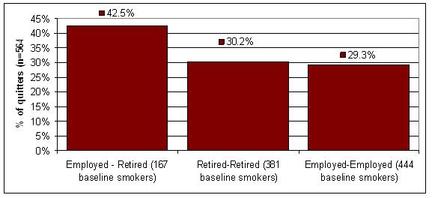ASHES, 4(9) – Life transitions inspire smoking cessation
Major life transitions might present the opportunity, perhaps even serve as the stimulus, to accomplish other transitions, such as changing identities from a smoker to a non-smoker. This week’s ASHES examines whether people who transition from worker to retiree quit smoking at a higher rate than people who remain employed (Lang, Rice, Wallace, Guralnik, & Melzer, 2007).
Methods
- The authors analyzed data from a sub-sample of the English Longitudinal Study of Ageing (ELSA), a UK-based prospective study of the general population.
- The study sample included 1,712 people who were smokers when they participated in the Health Survey for England (HSE) during 1998, 1999, or 2001, and who were 50 years old or older during the 2002 follow-up survey. The participants reported their current work status during each interview.
Measures
- Follow-up smoking status: persistent smokers (n=1,148); non-smokers (n=564)
- Cotinine levels corroborated self-reported smoking status
- Employment status:
- Employed at baseline, employed at follow-up (Employed-Employed)
- Employed at baseline, retired at follow-up (Employed-Retired)
- Retired at baseline, retired at follow-up (Retired-Retired) and,
- Other (e.g., long-term disability, full-time caregiver)
Results

Figure. Smoking cessation rates by baseline and follow-up work status, all ages. Adapted from Lang et al., 2007. Click image to enlarge.
- About one third of the sample quit smoking (32.9%) between baseline and follow-up interviews.
- The odds ratios for quitting smoking, among people aged 55-70 and excluding people who retired for health reasons, in a fully adjusted model with a sensitivity analysis, reflected a statistically significant increased rate of quitting among people who were transitioning their status from employed to retired:
- Employed-employed 1.00 (referent)
- Employed-retired 2.33 (95% CI 1.24-4.38)
- Retired-retired 1.26 (95% CI 0.66-2.42)
Limitations
- Self report methodology
- The researchers did not investigate concomitant changes that might explain some of the difference in quit rates between the three groups. For example, people working in certain occupations might have been less likely to quit smoking than people working in other occupations.
- We cannot determine how many people relapsed, and when they might have relapsed, after the follow-up interview.
Conclusion
More people quit smoking after they retired compared to people who remained working. Although quitting smoking as soon as possible is important for the health of all smokers, smokers and health professionals can emphasize retiring as a developmental opportunity to change smoking patterns. This also might provide an opportunity to change other substance use patterns as well. Future research will need to identify the reasons people quit smoking after they retire. Health professionals can use this information to encourage prospective retirees to follow suit.
–Leslie Bosworth
Reference
Lang, I. A., Rice, N. E., Wallace, R. B., Guralnik, J. M., & Melzer, D. (2007). Smoking cessation and transition into retirement: Analyses from the English Longitudinal Study of Ageing. Age and Ageing, 36, 638-643.
What do you think? Please use the comment link below to provide feedback on this article.